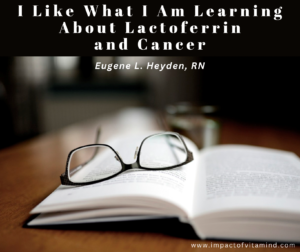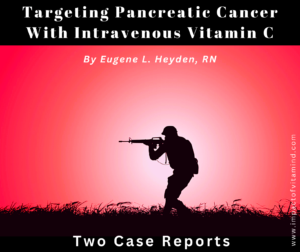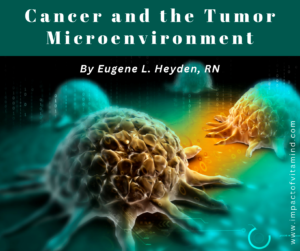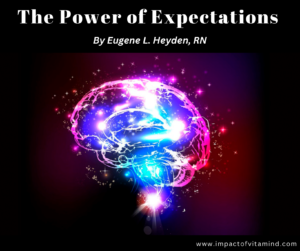I.V. Vitamin C in Palliative Care
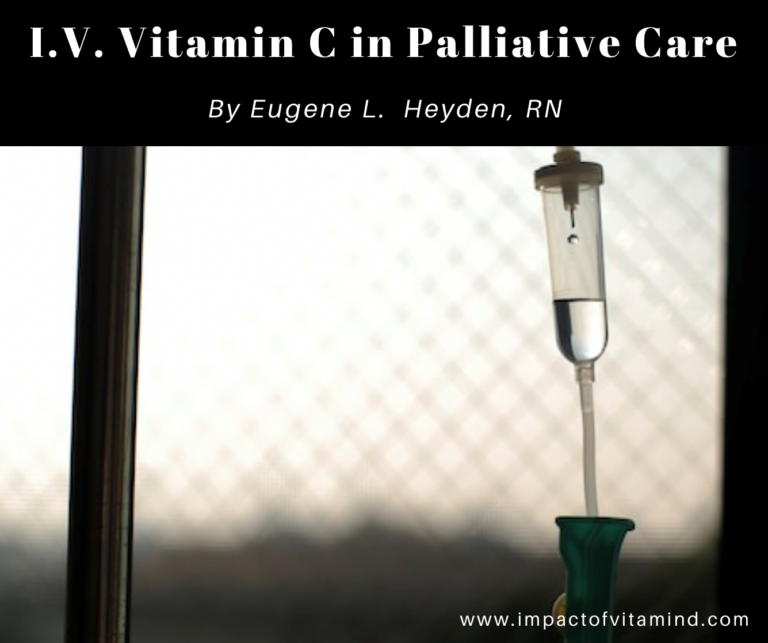
Last update: 06-06-23
By Eugene L. Heyden, RN
“VitC monotherapy in palliative care alleviates cancer-related pain and fatigue and improves the patients’ quality of life.” ~ Li et al., 2022
“In palliative care, high-dose VitC is currently gaining ground due to its highly safe and tolerable profile. Not only is high-dose VitC known to relieve pain in cancer patients, vast clinical evidence suggests that it has a significant positive impact on patients’ well-being.” ~ Böttger et al., 2021
Near the end, quality of life is most important. Certainly, no one wants to suffer; and no one wants to watch the suffering of someone they love. When the time arrives for palliative care, it would appear that I.V. vitamin C has much to offer—decreased pain, less fatigue, and an increased sense of wellbeing. However, only a few patients are offered I.V. vitamin C to ease their suffering, even at the time of their greatest need. Why? Why are so few offered and given this form of palliative care? Unfortunately, it all boils down to a monumental mistake made some 50 years ago. To place things in perspective,
“In the early 1970s Cameron and Pauling described dramatic decreases in opiate dependence in five patients with advanced cancer following high dose vitamin C administration. These patients were in considerable pain due to skeletal metastases and were receiving large regular doses of opiate analgesics (morphine or diamorphine). Within five to seven days of commencing vitamin C, four of the five patients became completely free from pain, and the fifth required only mild analgesics.” (Carr and McCall, 2017)
Perhaps most remarkable, in 1974 “Cameron and Campbell reported a number of cases of dramatic to complete amelioration of bone pain in patients with severe cancer-related pain given both high dose oral and intravenous vitamin C.” (Carr and McCall, 2017, emphasis added)
All this must have been so exciting! There is usually not a lot of good news when it comes to cancer, but now there was. And in an effort to see if what was reported could be validated, vitamin C as a cancer therapy was put to the test by an investigative team associated with the Mayo Clinic.
At the time, not realizing or taking into account that there was a profound difference between what can be achieved by oral vitamin C and what can be achieved by I.V. vitamin C, an investigative team associated with the Mayo Clinic used oral vitamin C (only) in their studies to validate the initial work of Cameron and Pauling. “Subsequent double-blind, randomized clinical trials at the Mayo Clinic failed to show any benefit, and the role of vitamin C in cancer treatment was discarded by mainstream oncologists. Vitamin C continues, however, to be used as an alternative cancer therapy.” (Padayatty et al., 2006) And yet the results of Cameron and Pauling were quite impressive and could not be ignored. “Cameron and Pauling observed fourfold survival times in terminal cancer patients treated with intravenous ascorbate infusions followed by oral supplementation.” (Mikirova et al., 2013, emphasis added)
Looking back, failure by the Mayo clinic investigators could have been predicted—in as much as oral vitamin C can only bring a blood level of the vitamin to a relatively low level and not to a chemotherapeutic level. However, by giving vitamin C intravenously, the blood level of vitamin C can be raised up to 200 times above that which can be achieved by oral vitamin C alone (Verrax et al., 2009). Now this is a therapeutic level! And at such concentrations, vitamin C can exhibit impressive anticancer properties. The flaws and shenanigans of the Mayo Clinic-associated investigators (e.g., refusal to release certain data in their study), along with the hostile attitude toward the work of Cameron and Pauling in general (see Hoffer, 2000), did not deter other investigators, those who have seen results, who see the possibilities, who were aware of the fundamental error made by the Mayo Clinic investigators, and who subsequently did not write off I.V. vitamin C. Currently, one can easily find research paper after research paper that would be in support the following:
“IV Vitamin c [C] dose of more than 100 grams per day given in slow infusion are not toxic to cancer patients. Moreover, some cancer patients have had complete remission of their cancer after a series of high dose intravenous vitamin C infusions. Also high doses of IV vitamin C have not interfered with the effect of conventional therapy and may decrease toxicity of chemotherapy.” (Riordan et al., 2004)
Unfortunately, the cultivated biases against I.V. vitamin C as a cancer therapy has spilled over to the use of I.V. vitamin D for palliative care. And as a consequence, people suffer unnecessarily. Perhaps it is your loved one who is adversely affected. Largely ignored is the fact that terminal cancer patients are notoriously deficient in vitamin C, Indeed, “In a study by Mayland et al., severe vitamin C deficiency was found in 30% of hospice residents with advanced cancer. Riordan et al. observed severe ascorbate deficiency in 50% of terminal cancer patients.” (Zasowska-Nowak et al., 2021). And this is not without consequence.
“Symptoms of vitamin C deficiency include fatigue, weakness, poor wound healing, ecchymoses [bruising or bleeding discoloration], xerosis [dry skin], lower extremity edema, and musculoskeletal pain—most of them are often observed in end-stage cancer patients.” (Zasowska-Nowak et al., 2021) With respect to palliative care, it is the pain that is most concerning. And for whatever the reason, I.V. vitamin C can come to the rescue.
“It remains uncertain, which of the biological properties of vitamin C is responsible for its potential analgesic effect. It was shown by Mikirova et al. that high-dose IVC may reduce inflammation in cancer patients, and these anti-inflammatory properties of vitamin C may play a key role in certain clinical situations, such as cancer-induced bone pain.” (Zasowska-Nowak et al., 2021)
At this point in the conversation, we could probably use an impressive case report (you’re nodding “yes”).
Case report
This is the story of an 81-year-old gentleman who had previously been diagnosed as having a rare cancer on his left pulmonary artery. The year, 2004. After surgical resection of tumor and lung, and after recovery, life was good for another 8 years. This brings us to 2013. Unfortunately, this was the year he was diagnosed with “recurrent pulmonary angiosarcoma . . . and deemed inoperable by his oncologist. It was time to reach for the I.V. vitamin C. It was also time to use a carefully designed, quality of life questionnaire in order to evaluate responses.
Likely without significant delay, intravenous vitamin C, 30 grams per session, was initiated. The treatment course was for 7 days (presumably 7 consecutive days). The quality of life questionnaire was completed before then after therapy. And get this:
“The quality of life questionnaire showed a 37% decrease in fatigue (from a score of 90 to a score of 57) and complete cessation of pain, nausea/vomiting and insomnia, as well as reduced loss of appetite, following vitamin C administration. Improvements inphysical, emotional, cognitive and social functioning were also observed, as well as an enhancement of overall quality of life. With respect to the multidimensional aspects of fatigue, there were decreases in general, physical, emotional and mental fatigue, resulting in a 50% decrease in total fatigue following vitamin C administration.” (Carr et al., 2014)
And I love how the story ends.
“Prior to vitamin C administration the patient was wheelchair bound, unable to walk unaided and totally dependent on physical assistance. Following vitamin C
administration there was a complete reduction in pain (notably he no longer required analgesics), he was able to walk and do many other daily activities unaided, and he experienced a dramatic decrease in fatigue levels. The patient’s primary carer also reported that the patient developed a more positive outlook on life. No adverse side effects of the vitamin C treatment were observed by the patient’s primary carer and GP.” (Carr et al., 2014)
Dosages and routes of administration
With respect to palliative care, Carr and McCall give us insight into dosages and routes of administration. They report:
“Retrospective studies of patients with bone metastases receiving 2.5 g intravenous vitamin C once weekly or during intensifying pain reported a range of responses, including 0–100% decreases in pain. These, and the earlier case studies, indicate that vitamin C can potentially provide dramatic improvements in pain relief in cancer patients with bone metastases.” (Carr and McCall, 2017)
Interestingly, with respect to I.V. vitamin C in palliative care, the dosages required for pain management are substantially less than required for cancer therapy. In fact, effective dosages can be achieved by oral administration. Carr and McCall report dramatic to complete relief of metastatic bone pain has been achieved with I.V. vitamin C followed by 8 to 10 g/daily of oral vitamin C. (Carr and McCall, 2017, Table 3.) To underscore the power of oral vitamin C, aptly demonstrated in a painful bone disease, “An early study in 16 patients with Paget’s disease of bone showed that oral doses of 3 g/day vitamin C for 2 weeks decreased pain in 50% of the patients and resulted in a complete elimination of pain in 20% of the patients.” (Carr and McCall, 2017)
Fortunately, in situations where I.V. vitamin C is not offered or is otherwise inappropriate, one may be able to achieve benefit from oral vitamin C, similar to that outlined above. There are liposomal, sublingual, and nano- vitamin C preparations available that proport increased absorption. Perhaps by taking such preparations and with frequent dosing, a palliative level of vitamin C, somewhere in the range of 8 to 10 g/day can be achieved. And, you never know, with an enhanced absorption formula, a lesser amount of vitamin C supplementation may be required to achieve a satisfactory degree of pain control.
Related posts: (Click image to view)
References
Carr A, Vissers MC, Cook J. Parenteral vitamin C for palliative care of terminal cancer patients. The New Zealand Medical Journal (Online). 2014 Jun 20;127(1396). https://search.proquest.com/openview/a1c1f6b1aa4109bc950c6542fb653ef0/1?pq-origsite=gscholar&cbl=1056335
Carr AC, McCall C. The role of vitamin C in the treatment of pain: new insights. Journal of translational medicine. 2017 Dec;15:1-4. https://link.springer.com/article/10.1186/s12967-017-1179-7
Hoffer LJ. Vitamin C: Case History of an Alternative Cancer Therapy. Journal of Orthomolecular Medicine. 2000;15(4):181-8. https://isom.ca/wp-content/uploads/2020/01/JOM_2000_15_4_03_Vitamin_C_Case_History_of_an_Alternative_Cancer_Therapy.pdf
Mikirova N, Casciari J, Riordan N, Hunninghake R. Clinical experience with intravenous administration of ascorbic acid: achievable levels in blood for different states of inflammation and disease in cancer patients. Journal of translational medicine. 2013 Dec;11:1-0. https://link.springer.com/article/10.1186/1479-5876-11-191
Padayatty SJ, Riordan HD, Hewitt SM, Katz A, Hoffer LJ, Levine M. Intravenously administered vitamin C as cancer therapy: three cases. Cmaj. 2006 Mar 28;174(7):937-42. https://www.cmaj.ca/content/174/7/937?sid=c4b055
Riordan HD, Riordan NH, Jackson JA, Casciari JJ, Hunninghake R, González MJ, Mora EM, Miranda-Massari JR, Rosario N, Rivera A. Intravenous vitamin C as a chemotherapy agent: a report on clinical cases. Puerto Rico health sciences journal. 2004;23(2). https://prhsj.rcm.upr.edu/index.php/prhsj/article/download/469/332
Verrax J, Calderon PB. Pharmacologic concentrations of ascorbate are achieved by parenteral administration and exhibit antitumoral effects. Free Radical Biology and Medicine. 2009 Jul 1;47(1):32-40. https://www.sciencedirect.com/science/article/pii/S0891584909001105
Zasowska-Nowak A, Nowak PJ, Ciałkowska-Rysz A. High-dose vitamin C in advanced-stage cancer patients. Nutrients. 2021 Feb 26;13(3):735. https://www.mdpi.com/1012300
DISCLAIMER: This article is offered solely for informational purposes. The information contained therein and opinions expressed should be evaluated for accuracy and validity in the context of opposing data, new information, and the views and recommendations of a qualified health care professional, and not to be substituted for professional judgment and guidance or to provide a reason to neglect or delay appropriate medical care for self or for others. It is the reader, and reader only, who bears the responsibility for any actions that could be construed as being a response to the information presented. The statements and opinions expressed by the author have not been reviewed or approved by the FDA or by any other authoritative body, nor is the author endorsing any product or specific therapy mentioned. This article and the opinions contained therein are offered to the reader to broaden his or her understanding of the issues discussed and to help identify options that may be suitable for the individual to pursue, on behalf of self or others, under approval and direction of a qualified physician or medical team member. All questions of a medical nature which arise from reading this article should be directed at qualified health care professional. There are no guarantees that a suggested website and internal links are safe to visit or open or are currently available.
Copyright © 2023 Eugene L. Heyden, RN
All Rights Reserved


